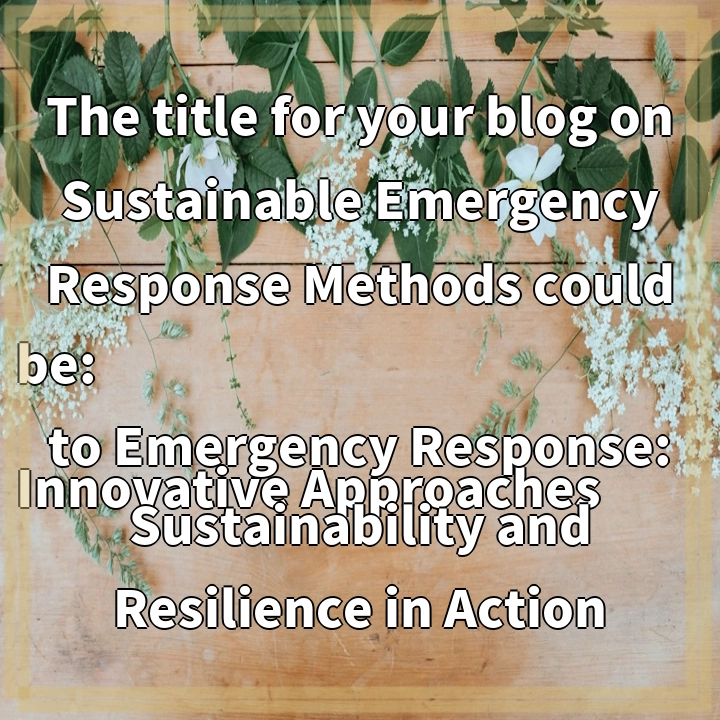
What it is:
Sustainable emergency response methods refer to approaches and strategies implemented during natural disasters, emergencies, or crises that aim to minimize negative environmental impacts and promote long-term resilience. These methods prioritize the use of renewable resources, reduce waste generation, and focus on community engagement and empowerment.
Sustainable emergency response integrates principles of sustainability, such as resource conservation, climate change mitigation and adaptation, and social equity, into traditional emergency management practices. The goal is to effectively address immediate needs while also considering the long-term effects on the environment and community.
By adopting sustainable emergency response methods, governments, organizations, and communities can not only mitigate environmental impacts but also enhance their overall resilience to future emergencies.
Real-world problems associated with sustainable emergency response:
While sustainable emergency response methods have numerous benefits, several challenges and problems must be addressed to ensure their successful implementation:
1. Limited awareness and understanding:
One of the primary challenges is a lack of awareness and understanding about sustainable emergency response methods among emergency management professionals, policymakers, and the general public. Education and outreach efforts are needed to promote and explain the importance and benefits of sustainability in emergency response.
2. Resource limitations:
Adequate resources, such as funding, personnel, and supplies, are essential to effectively implement sustainable emergency response methods. However, resource constraints, especially in developing regions and marginalized communities, can hinder the adoption of sustainable practices. identifying and securing resources is a significant challenge in many cases.
3. Complex logistics:
Emergency response involves numerous logistical challenges, such as transportation, communication, and coordination. Integrating sustainability considerations into these complex systems may require substantial planning, collaboration, and innovative solutions.
4. Short-term vs. long-term priorities:
Balancing short-term emergency needs with long-term sustainability goals can be challenging. In crisis situations, immediate responses may take precedence over long-term environmental considerations. Striking the right balance between these priorities requires careful planning and decision-making.
5. Cultural and social factors:
Sustainable emergency response methods must be culturally sensitive and tailored to the specific needs and values of the affected communities. Considering social dynamics, cultural practices, and community perspectives is crucial to ensure the effectiveness and acceptance of sustainable strategies.
Overcoming these challenges requires collaboration among various stakeholders, including emergency management organizations, government agencies, NGOs, and community members. By addressing these real-world problems, we can progress towards a more sustainable and resilient approach to emergency response.

Solutions to the challenges of sustainable emergency response:
Addressing the real-world problems associated with sustainable emergency response requires proactive measures and collaborative efforts. Here are some potential solutions:
Educational initiatives:
Increasing awareness and understanding of sustainable emergency response methods through educational programs, training workshops, and public outreach. This will help build knowledge and capacity among emergency management professionals, policymakers, and the public.
Resource mobilization:
Actively seeking and securing resources, such as funding, personnel, and supplies, to support the incorporation of sustainable practices into emergency response efforts. Collaboration with governmental and non-governmental agencies, community partnerships, and leveraging existing resources can help overcome resource limitations.
Integrated planning:
Incorporating sustainability considerations into emergency response planning from the outset. This involves integrating sustainable strategies into logistics, communication systems, and decision-making processes. Collaborative planning with input from diverse stakeholders can help identify innovative solutions.
Long-term thinking:
Encouraging the adoption of long-term thinking in emergency response, balancing immediate needs with sustainable outcomes. This requires strategic planning, frameworks that consider environmental and social impacts, and decision-making processes that prioritize resilience and sustainability.
Cultural sensitivity:
Incorporating cultural and social factors into sustainable emergency response methods, understanding and respecting the specific needs and values of affected communities. Engaging with local communities, promoting inclusive decision-making processes, and tailoring strategies to local contexts can help ensure the effectiveness and acceptance of sustainable practices.
By implementing these solutions, sustainable emergency response methods can become more widespread, effective, and resilient. They can help minimize environmental impacts, enhance community well-being, and contribute to long-term sustainability in the face of emergencies and crises.















